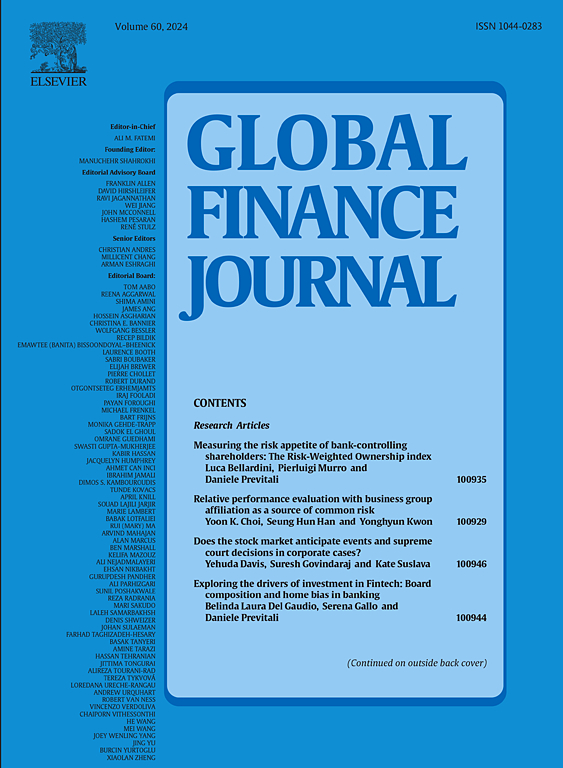评估全球供应链基础设施组合中的动态连通性:风险因素和极端事件的影响
IF 5.5
2区 经济学
Q1 BUSINESS, FINANCE
引用次数: 0
摘要
本文分析了全球供应链投资风险因素(即能源市场、投资者情绪和全球运输成本)。然后给出响应动态风险的投资组合策略。我们使用一套环境、社会和治理(ESG)指数,采用时变向量自回归模型考察了2010年1月5日至2023年6月29日期间这些因素之间的溢出效应和相互关联性。计算对冲比率(hr)和对冲有效性(HE),以确定这些投资组合的最佳多头和空头头寸。然后,我们通过比较COVID-19之前和之后的时期,评估极端事件对风险溢出和投资策略的影响。我们的研究结果表明,风险冲击推动了基础设施投资组合之间的动态连通性,我们强调了极端事件如何影响溢出效应和投资结果。ESG得分较高的投资组合与其他投资组合和因素的联系更强。净总定向连通性表明,西德克萨斯中质原油(WTI)、波罗的海干油交易所指数(Baltic Exchange Dry Index)和投资者情绪波动指数(VIX)是外溢冲击的一致净接收方,而GLFOX投资组合交替充当时变接收方和发送方。两两连通性分析表明,WTI和VIX主要是接收器,而CSUAX、GII和FGIAX组合则是净发射器。COVID-19改变了投资组合的动态连通性结构:平均人力资源和HE的变化表明,多/空头寸权重在疫情爆发后发生了结构性变化,ESG得分较高的投资组合表现出更强的对冲能力。这些发现为投资者调整全球供应链基础设施投资的对冲策略提供了有价值的见解。本文章由计算机程序翻译,如有差异,请以英文原文为准。
Assessing dynamic connectedness in global supply chain infrastructure portfolios: The impact of risk factors and extreme events
This paper analyzes global supply chain investment risk factors (i.e., energy market, investor sentiment, and global shipping costs). It then presents portfolio strategies responsive to dynamic risks. We employ a time-varying vector autoregression model to examine the spillovers and interconnectedness among these factors from January 5, 2010, to June 29, 2023, using a set of environmental, social, and governance (ESG) indexes. Hedge ratios (HRs) and hedging effectiveness (HE) are calculated to determine optimal long and short positions for these portfolios. We then assess the impact of extreme events on risk spillovers and investment strategies by comparing periods before and after COVID-19. Our results show that risk shocks drive dynamic connectedness among infrastructure portfolios, and we highlight how extreme events affect spillovers and investment outcomes. Portfolios with higher ESG scores exhibit stronger connectedness with other portfolios and factors. Net total directional connectedness indicates that West Texas Intermediate (WTI), the Baltic Exchange Dry Index, and the investor sentiment volatility index (VIX) are consistent net receivers of spillover shocks, while the GLFOX portfolio alternates as a time-varying receiver and transmitter. Pairwise connectedness analysis reveals that WTI and VIX are predominantly receivers, whereas CSUAX, GII, and FGIAX portfolios act as net transmitters. COVID-19 altered the structure of dynamic connectedness across portfolios: shifts in mean HR and HE suggest that long/short position weights underwent structural changes post-outbreak, and portfolios with higher ESG scores demonstrated superior hedging ability. These findings offer valuable insights for investors adjusting hedging strategies in global supply chain infrastructure investments.
求助全文
通过发布文献求助,成功后即可免费获取论文全文。
去求助
来源期刊

Global Finance Journal
BUSINESS, FINANCE-
CiteScore
7.30
自引率
13.50%
发文量
106
审稿时长
53 days
期刊介绍:
Global Finance Journal provides a forum for the exchange of ideas and techniques among academicians and practitioners and, thereby, advances applied research in global financial management. Global Finance Journal publishes original, creative, scholarly research that integrates theory and practice and addresses a readership in both business and academia. Articles reflecting pragmatic research are sought in areas such as financial management, investment, banking and financial services, accounting, and taxation. Global Finance Journal welcomes contributions from scholars in both the business and academic community and encourages collaborative research from this broad base worldwide.
 求助内容:
求助内容: 应助结果提醒方式:
应助结果提醒方式:


